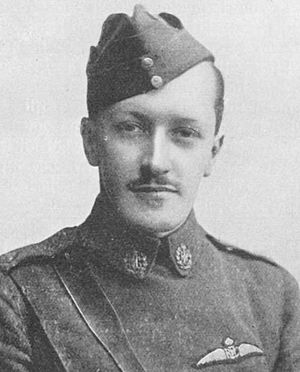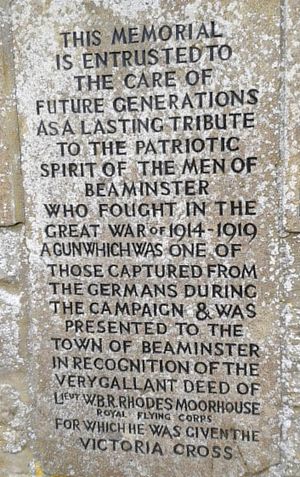William Barnard Rhodes-Moorhouse facts for kids
Quick facts for kids
William Barnard Rhodes-Moorhouse
|
|
|---|---|
 |
|
| Birth name | William Barnard Moorhouse |
| Born | 26 September 1887 Rokeby, Yorkshire, England |
| Died | 27 April 1915 (aged 27) Merville, France |
| Buried |
Parnham House, Dorset, England
|
| Allegiance | |
| Service/ |
Royal Flying Corps |
| Years of service | 1914–1915 |
| Rank | Lieutenant |
| Unit | No. 2 Squadron RFC |
| Battles/wars | World War I |
| Awards | Victoria Cross |
| Relations | William Henry Rhodes-Moorhouse (son) William Barnard Rhodes (grandfather) William Sefton Moorhouse (uncle) Mary Rhodes Moorhouse-Pekkala (sister) |
William Barnard Rhodes-Moorhouse was a brave English pilot. He was the first airman to receive the Victoria Cross. This is the highest award for courage in battle for British and Commonwealth forces. He earned this honor during World War I.
Contents
A Brave Pilot: William Rhodes-Moorhouse
Early Life and Flying Adventures
William Barnard Moorhouse was born in Rokeby, Yorkshire, England, on September 26, 1887. His mother, Mary Ann Rhodes, had a special family background. Her father, William Barnard Rhodes, was a whaling captain. He became an important businessman in Wellington, New Zealand. Mary Ann's mother was from the Māori people of New Zealand. She belonged to the Taranaki, Ngati Tama, Ngati Ruanui, and Te Āti Awa tribes.
William went to Harrow School and briefly attended Trinity Hall, Cambridge. He left college in 1909. That same year, he took private flying lessons. He quickly earned his pilot's certificate. William was not just a pilot; he also designed aircraft. He loved aviation races. He made history by being the first person to fly across the English Channel with two passengers. He flew from Douai, France, to Ashford, England, in a biplane. His wife and a journalist were with him.
In 1912, William changed his last name to Rhodes-Moorhouse. This was a requirement from his grandfather's will. He married Linda Beatrice Morrit, who also loved flying.
Heroic Actions in World War I

When World War I began, William joined the Royal Flying Corps. This was an early air force. He wanted to fly in combat. On March 20, 1915, he was sent to No. 2 Squadron RFC in Merville, France. He flew a B.E.2 aircraft.
On April 26, 1915, William was given a dangerous mission. He had to attack a railway junction in Kortrijk, Belgium. He flew very low over the target. He dropped his 100-pound bomb. Immediately, he faced heavy gunfire from the ground. Rifles and a machine-gun in a church tower fired at him. He was badly wounded in his leg. His plane was also hit many times.
Despite his injuries, William started flying back to the Allied lines. He again faced more gunfire from the ground. He was wounded two more times. Even with his plane damaged and himself severely hurt, he managed to fly his aircraft all the way back. He insisted on giving his report about the mission before getting medical help. He died the next day, April 27, 1915.
For his incredible bravery, William was given the Victoria Cross. The award recognized his courage. It said he flew to Courtrai, dropped bombs, and was mortally wounded. Yet, he flew 35 miles back at a low height. He reported his success before he died. His body was returned to England. He was buried at his family home, Parnham House, in Beaminster, Dorset.
A Son's Legacy: William Henry Rhodes-Moorhouse
William's son, also named William, was less than a year old when his father died. The son, known as Willie, grew up to be a pilot too. He joined No. 601 Squadron RAF during World War II. In 1940, during the Battle of Britain, he was shot down over Kent. He was killed in action. This happened shortly after he received the Distinguished Flying Cross for his own bravery.

